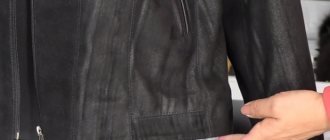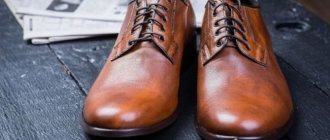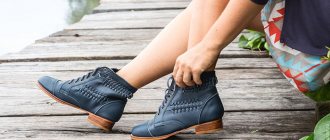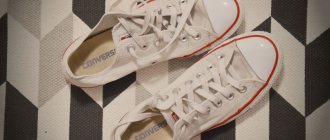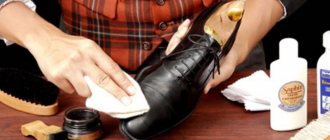To effectively care for leather shoes, you need professional products: cleaning foams and sponges “Divide”, “Master Shine”, nourishing cream Kiwi, Salton, salamander impregnation, Wax Erdal, cream dyes for leather Salton, Twist Fashion, CHIST. Home remedies: softness - petroleum jelly, glycerin, shine - ammonia alcohol, water protection - fish oil, linseed oil. Seasonal shoe care includes cleaning the inner surfaces and insoles in the summer, thorough drying in the winter, and additional protection with water-repellent agents in the spring and fall. Stains and odors can be removed using traditional methods using salt, talc, baking soda, vinegar, hydrogen peroxide, glycerin. Fabric or cardboard packaging is used for storage.
Proper care of leather shoes begins with their purchase; it includes a daily set of measures aimed at keeping them clean and dry, as well as protecting them from dirt and moisture.
Primary processing of shoes after purchase
Caring for new shoes after purchase consists of:
- applying a hydrophobic agent;
- drying 12-15 hours;
- impregnation with protective cream.
Within 7-14 days after active wearing, the course of treatment is repeated.
Manufacturers recommend taking leather shoes home before going out for the first time to ensure they fit properly on your feet. If you bought a slightly shiny pair, lightly dampen the inside of the fabric with vinegar and leave it on the foot until dry. Thus, shoes or boots will be more acceptable in the shape of the owner's foot.
Advice! Before you wear the pair you just bought, leave them unpacked for 2-3 days. Leave the inside filling for writing the form (paper, cardboard, plastic dividers). The leather will regain its original shape and smoothness after being transported and stored in a shoe store.
If you have an unpleasant “chemical” smell, especially if you bought your shoes second-hand, air them out during the day or treat the inside with a cloth soaked in vinegar or hydrogen peroxide.
How to store leather shoes at home?
Most importantly, you must keep your shoes clean and dry and use special products for leather shoes.
- To maintain the shape of the leather shoes you wear, often use shoe holders. ...
- Use silica gel: ...
- Clean your shoes thoroughly before storing. ...
- Choose a suitable way to store your shoes.
Oct 2
2022 Interesting materials:
Whose sign is Topaz? Trans fats what? What does the elliptical trainer train? What kind of elliptical trainer? How to repair a crack in the ceiling? What are truffles? What area is the center of St. Petersburg? Thuja how to propagate thuja from cuttings? Enterprise loss as a financial result? UIN what is this?
Products for the care of shoes made of genuine leather
Leather products must be treated with store-bought or inexpensive home care products to maintain their appearance, warmth, and water-repellent properties.
Professional shoe cleaning products
A number of products will help you care for shoes made of genuine leather, including waterproof nourishing creams, color-restoring dyes and sponge impregnations.
Table 1. Shoe care products
| Name | Volume | price, rub. |
| Daily care | ||
| "Dividik" foam cleaner | 125 ml | 110 |
| "Master shine" sponge | 1 PC. | 31 |
| Salton sponge with dispenser | 1 PC. | 135 |
| Salamander | 1 PC. | 120 |
| Nutritious cream | ||
| Kiwi | 50 ml | 69 |
| "Master Shine" | 50 ml | 15 |
| Salton | 50 ml | 53 |
| Salamander | 75 ml | 115 |
| Water-repellent impregnation | ||
| Spray Silver | 250 ml | 180 |
| Salamander | 300 ml | 299 |
| Erdal wax | 75 ml | 133 |
| Leather paint | ||
| Silver | 75 ml | 92 |
| Salton | 250 ml | 249 |
| Twist Fashion | 250 ml | 243 |
| Cream paint CHIST | 60 ml | 47 |
The product range is available in different versions, depending on the type and color of the material.
It’s also worth getting brushes, sponges and wipes for proper care.
Traditional methods of caring for leather shoes
Home remedies can replace shoe care or store-bought shoe care products.
Protect from drying out
Castor oil or any other vegetable oil will help restore the softness of dry leather shoes. Wipe, dry and polish with a soft cloth.
Suitable for shoes and nourishing cosmetics for hands, body, face, baby cream. Just put them on the surface and rub them in, let them in.
Regular Vaseline or glycerin will save the skin from cracking.
Bringing back the shine
To give your skin a glow, treat it with a solution of ammonia (1/2 teaspoon per glass of water). Dampen the cloth, thoroughly wipe the shoes, and perform final polishing with a rag. For better cleaning, add 1 tablespoon of liquid baby soap to the mixture.
Apply a foam of equal parts whipped milk, egg white and sugar and let dry. Remove any remaining foam with a flannel sponge.
Create a water-repellent barrier
To protect against moisture, prepare a solution of fish oil, turpentine and wax (20: 2: 5) in a water bath. Pour the mixture over the product and let it dry.
Lard (unsalted), fish oil and flaxseed oil are water resistant. Rub into any center, carefully working the seams.
Important: do not apply several layers of different products (home or professional) at the same time. Leather for shoes should “breathe”.
Water-repellent impregnations
Water-repellent impregnations are used to protect shoes from getting wet. They cover the surface with a thin layer so that it is protected from moisture, but “breathes” just as well as before.
Water repellents are as follows:
- Impregnation. Products containing fluoride can be used for any type of shoes. Impregnations with fluorocarbon resin are suitable for suede and nubuck. Silicone is considered a favorite among owners of leather shoes, as it does not allow water to even slightly wet the leather. The impregnation begins to act only 9-10 hours after application, so it is better to treat shoes in the evening.
- Water-repellent spray is the most convenient to use because it does not require additional brushes or sponges. Plus - it retains color. It also has a downside - a very unpleasant, pungent odor, so it should be applied in the fresh air or in a well-ventilated area.
- Creams. Their advantage is that, in addition to repelling moisture, they moisturize the skin and protect it from cracks.
- Unsalted lard, which should be used to rub shoes. It will protect your shoes from both moisture and frost.
Subtleties of seasonal shoe care
To extend the life of your shoes, care for them at home every day, depending on the season and weather conditions.
Summer shoe care
A special feature of caring for summer models is the need to clean the outer and inner surfaces of sandals and insoles, where road dust easily penetrates.
In summer, clean your shoes with soapy water.
Clean the outside with a cloth soaked in soapy water. Wipe lightly soiled insoles with a damp, antibacterial cloth. Wipe very dirty pads with traces of dust with a cotton pad soaked in hydrogen peroxide.
Summer suede models require careful cleaning of dust with a special rubberized brush and subsequent treatment with a protective spray. Do not let the material get wet.
Patent leather sandals do not wear quickly, wipe them with a damp sponge and carefully remove moisture with a flannel. To preserve the paintwork, rub in a couple of castor oils (glycerin or petroleum jelly) once a week.
Winter shoe care
Processing leather or suede models of winter boots involves thoroughly drying, impregnating and protecting the product:
- Immediately upon return, wipe the product with a dry cloth.
- If salt stains persist, remove them with soap and water.
- We take out the inserts and put them to dry.
- Periodically (twice a month) wash the insoles in a thick soap solution. Contact the retailer when purchasing insoles to find out if this procedure is possible. Typically, all insoles can be removed and gently washed by hand.
- If your shoes are wet, stuff them with old newspapers or use an electric dryer.
- The main thing is that you cannot place shoes near the radiator; the leather dries out, cracks, and the sole and heel become deformed.
- Treat the product with nourishing cream to protect it from frost.
Important! Do not use shoe cosmetics containing silicone for winter care. The substance freezes at low temperatures and may damage skin.
Shoe care in the off-season (spring, autumn)
The main task is to protect against penetration and absorption of moisture.
Semi-seasonal care includes evening and morning treatment:
- Dirt should be removed immediately upon return without allowing it to dry.
- Lubricate the surface with shoe polish. Suitable dyes should be used for black and brown shoes. Colored shoes should be treated with colorless cream. For lacquered models we use sprays, oils and polishes, o.
- If your shoes get wet, let them dry until the morning and apply a hydrophobic agent 20 minutes before leaving the house.
Clean suede surfaces only when they are dry. Remove dirty fragments with a special brush or folk tools (thin paper, abrasive, nail file, eraser).
Advice: You should not wear suede shoes and boots during half the season. Moisture and dirt shorten their service life and spoil their appearance.
Useful tips and tricks
- Do not leave leather shoes near heating appliances or in the sun.
- Clean your shoes in a timely manner and take care of them regularly.
- Do not twist the backs when putting on and taking off shoes.
- It is advisable to have at least two pairs for the season, since wet skin takes more than a day to dry. Do not wear wet or damp shoes.
- Summer sandals should not be worn in the cold season, and winter boots will be inappropriate in warm weather. The main rule for using leather is to wear it according to the weather.
Cleaning genuine leather from various stains
When you decide to treat stains, use household chemicals or improvised means.
Salt stains
Professional cleaning products, foams, and impregnations from the Salton, Silver, and Divideek series will help protect and clean winter shoes from traces of salt and reagents.
Effective folk methods:
- Using a solution of 3 tablespoons of vinegar essence and 1 tablespoon of water, remove the white stripes and dry.
- A cotton pad soaked in alcohol, vodka or ammonia wipes the skin. After drying, rub into nourishing cream.
- Soft paper towels wrapped around wet shoes will absorb the water along with any traces of salt.
Street dirt
Leather goods dust is wiped off with a cloth soaked in a solution of washing soap. Clean seams, folds and laces with a toothbrush.
The water for washing should be cool; hot water will stretch the leather, deforming the product.
Do not use abrasive materials or hard sponges for cleaning.
Grease, oil stains
Sprinkle greasy strips with starch, baking soda, talcum powder, and crushed chalk. Leave for 1-3 hours. Shake, wipe with a damp cloth.
Rub half of the fresh onion over the fat splash. The stain should disappear.
Wipe the stain with a solution of baking soda (1 teaspoon per tablespoon of water). Leave for half an hour, wipe with a damp cloth.
Black stripes
Black streaks on white shoes can be erased with a pencil eraser or rubbed off with toothpaste.
A paste of baking soda will help remove black spots. Apply to prints, rub in and remove with soft flannel or cloth.
Scratches
Soften scratches with leather paint to make them less noticeable.
As an express tool, you can use a simple felt-tip pen or marker, matched to the color of your shoes.
Treat small scratches with a cotton swab dipped in olive oil. After drying, the marks will disappear.
Treat your shoes with cream or wax every 6–7 wears
And be sure to use the cream after each wet cleansing.
The product should be applied to dry, clean shoes. Do this in a circular motion using the sponge or soft microfiber cloth included in the cream packaging. The cream will protect the skin from the appearance of microcracks, and will also help it maintain elasticity and shine longer.
Photo: Olena Yakobchuk / Shutterstock
Finally, you can apply a polish and rub the surface with a soft brush or special wipes until a characteristic shine appears.
Removing odors from shoes
To eliminate unpleasant odors, suitable storage products are: aromatic sachets, special deodorants, ionizers or available home remedies.
Foot odor
To eliminate sweat odor, you can use:
- Vinegar, hydrogen peroxide, ammonia, manganese. Soak the cotton wool and treat the inner surface.
- Talc, baking soda, salt, crushed activated carbon. Pour into shoes, leave for 2-3 hours, shake.
- Additionally, you can wipe with peroxide, green tea, lemon balm or mint infusion. Moisten the napkin, wipe it, dry thoroughly.
Cat marks
Traces left by an animal should be removed immediately after its appearance, without allowing it to be absorbed:
- Stuff shoes with dry wipes and paper.
- after absorption, remove the rags,
- wipe the surface with vinegar.
- Sprinkle with baking soda and leave for another half hour.
- rinse with peroxide and dry.
Mold
Salt, baking soda or charcoal in shoes will eliminate the smell of dampness and mold. Carefully distribute the powder inside, put the shoes in a plastic bag for 12 hours, shake.
First eliminate the cause of mold: wipe the inner surface with “Belize” manganese solution and vinegar.
Special cases
When deciding how to properly care for a pair of shoes, you should consider the color and type of leather.
Taking care of colored shoes
The stores offer a wide selection of paints, varnishes and creams for colored leather. If you haven’t found a suitable shade, you can use colorless universal products.
Effective folk methods:
- yellow shoes treated with lemon juice;
- red – pomegranate juice or manganese solution;
- white - milk or egg white, whipped into foam;
- brown – brewed tea bags, coffee grounds.
Ammonia alcohol can restore shine to any color. Dampen a cotton pad, wipe the skin, let dry.
Caring for shoes made of reptile leather
These shoes belong to the premium class and require a responsible approach. It is better to use professional cosmetics with the correct labeling so that the precious steam lasts for a long time.
To clean reptile shoes, use only professional cosmetics.
Avoid prolonged contact of your shoes with water, heating devices and chemicals.
Daily care consists of wiping with a soft, slightly damp cloth, and then treating with a dry cloth to remove moisture, using special creams to prevent drying.
Which cream to choose?
Today the market offers a huge selection of creams aimed at protecting the leather surface. What characteristics should a quality product have, see below:
- choose products based on natural wax and organic oils;
- In order to protect the product from the influence of snow, water and frost, use a dense and viscous cream based on natural solvents . They will create a protective layer on the surface of the skin;
- choose a composition that does not contain alcohol or thickener. Otherwise, the protective layer of natural leather will gradually disappear.




